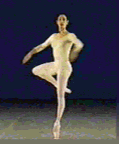
Aplomb
Encyclopedia

In classical ballet
Classical ballet
Classical Ballet is the most formal of the ballet styles, it adheres to traditional ballet technique. There are variations relating to area of origin, such as Russian ballet, French ballet, British ballet and Italian ballet...
, aplomb refers to the basic law of ballet - stability.
The French ballet master
Ballet Master
Ballet Master is the term used for an employee of a ballet company who is responsible for the level of competence of the dancers in their company...
Jean-Étienne Despréaux
Jean-Étienne Despréaux
Jean-Étienne Despréaux was a French ballet dancer, choreographer, composer, singer and playwright.He was an author of several opera parodies, appreciated by king Louis XV of France, including Berlingue based on Philidor's Ernelinde, princesse de Norvège.He retired in 1781 with pension of 1,000...
defined it in 1806 as a specific kind of dynamic balance fundamental to all positions and movements of (classical) ballet.
A 1905 book Grammar of the Art of Dancing, Theoretical and Practical referring to Bernhard Klemm, wrote: "Aplomb is the absolute safety in rising and falling back which results from the
perpendicular attitude of the upper body and the artistic placing of the feet. By means
of aplomb the dancer acquires a precision and an elegance which insure the successful execution
of every foot-movement, however artistic and difficult, and thereby creates a pleasing
and a satisfactory impression upon the observer. Aplomb may be compared with the
sureness of touch of the pianist."
Aplomb is achieved with straight body with its weight equally distributed over the supporting foot (or feet). Aplomb is controlled by feeling and controlling the muscular sensations in the spine
Vertebral column
In human anatomy, the vertebral column is a column usually consisting of 24 articulating vertebrae, and 9 fused vertebrae in the sacrum and the coccyx. It is situated in the dorsal aspect of the torso, separated by intervertebral discs...
, i.e., by "holding the back". The base of aplomb are the five positions of the feet codified by Pierre Beauchamp
Pierre Beauchamp
Pierre Beauchamp was a French choreographer, dancer and composer, and the probable inventor of Beauchamp-Feuillet notation.-Biography:...
in 1680.
The correct set of the body influences all ballet steps, and the perfection of the aplomb requires years of training. Exercises at the barre
Barre (ballet)
A barre is a stationary handrail that is used during ballet warm up exercises. The term also refers to the exercises that are performed at the barre, as well as that part of a ballet class that incorporates barre exercises.-Construction:...
begin the training of the stability and balance.

